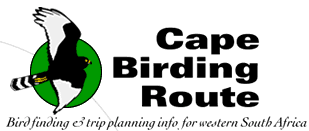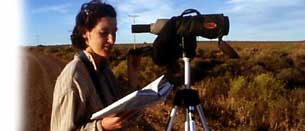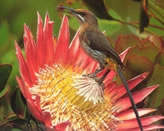|
Kimberley Area:
Kimberley
is often underestimated as a birding destination, despite
entering the birding limelight in 1996 with the discovery
here of a pipit new to science (Long-tailed Pipit,
see box overleaf). It also offers access to several other
species that are challenging to see in South Africa, such
as Bradfield’s Swift. A number of species that
occur here, such as Red-breasted Swallow, Crested
Barbet and Golden-breasted Bunting, are more characteristic
of South Africa’s eastern regions, and reach their western
point of distribution in this area.
Kimberley
is renowned as the site of a 19th-century diamond rush of
unprecedented madness, one that converted a small hillock
to what is now known as the Big Hole, a massive, water-filled
pit gouged into the earth’s surface. Today, despite its
status as the industrial and administrative centre of the
Northern Cape Province, the city is surrounded by natural
areas and flanked on virtually all sides by private game farms
that offer good dryland savanna birding.
The
city proper offers access to two sought-after birds: Bradfield’s
Swift and Long-tailed Pipit. Look for the former
at the Big Hole or De Beers Mine hole (follow the signs from
the N12) where they breed, or observe them flying overhead
anywhere in the city. Long-tailed Pipit is best sought
at its type locality, Beaconsfield Park (also known as Keeley
Park): follow the signs to the McGregor Museum and, leaving
from the gate of the museum, go left and take the first left
into Du Toits Pan Road and then the first right into Pratley
Road. Continue to the big gates at the end of the road. Enter
the park on foot, and turn left towards the series of playing
fields, where you will see pipits of all descriptions —
including, potentially, Long-tailed (winter), Plain-backed,
Buffy, Grassveld and ‘Kimberley’
(see feature on Kimberley's New Pipits).
The thorn trees between the fields and the gate support African
Hoopoe, Lesser Honeyguide, Acacia Pied Barbet,
Fiscal Flycatcher, Cape White-eye (see page
on changing
bird taxonomy) and Black-throated Canary. White-backed
Vultures can at times be seen soaring over the city.
Access
to most of the private land is limited. In addition to birding
the roadsides, you may consider visiting Marrick Game Farm,
which welcomes day visitors and also provides accommodation.
It is conspicuously signposted, 11 km west of Kimberley on
the R357 to Douglas (tel: (053) 861-1530). Marrick offers
a good combination of both savanna and open grassland, as
well as an ephemeral vlei that occasionally hosts large numbers
of waterbirds.
The
woodland abounds with typical acacia thornveld species such
as Scimitar-billed Woodhoopoe, Ashy Tit, Kalahari
Robin and Crimson-breasted Shrike. Also present
is the more easterly, small-billed subspecies of Sabota
Lark (see page on changing
bird taxonomy). The open grasslands near the pan supply
an entirely different selection of species, including Northern
Black Korhaan, Double-banded Courser (common here),
Anteating Chat, Clapper, Spike-heeled
and Red-capped Larks and sometimes, with careful checking,
Pink-billed Lark. Search the open parkland for the
uncommon Orange River Francolin, where tall, scattered
acacia trees stand above the grassy flats. This species, which
calls in the early morning and is responsive to playback,
displays a remarkable capacity to remain concealed. Although
reasonably common in the Kimberley area, this bird is perhaps
better looked for in the Free State or North West provinces
(for example, in the very productive Sandveld Nature Reserve
near Bloemhof), where it is more common and sites are more
accessible.
Just
north of Kimberley, on the N12 to Johannesburg, lies the vast
expanse of Kamfer’s Dam, one of the few perennial waterbodies
in the Northern Cape and, as such, supporting an exceptional
number and diversity of waterbirds. Access is possible through
the golf course on the southern side of the pan, or from the
adjacent N12 road. Waterbirds include Greater and Lesser
Flamingos, Black-necked Grebe and small numbers
of Chestnut-banded Plover. Reedbeds support Golden
Bishop, here at the edge of its range. South African
Cliff Swallow and, in wet years, Black-winged Pratincole
feed over the adjacent grassland.
|


